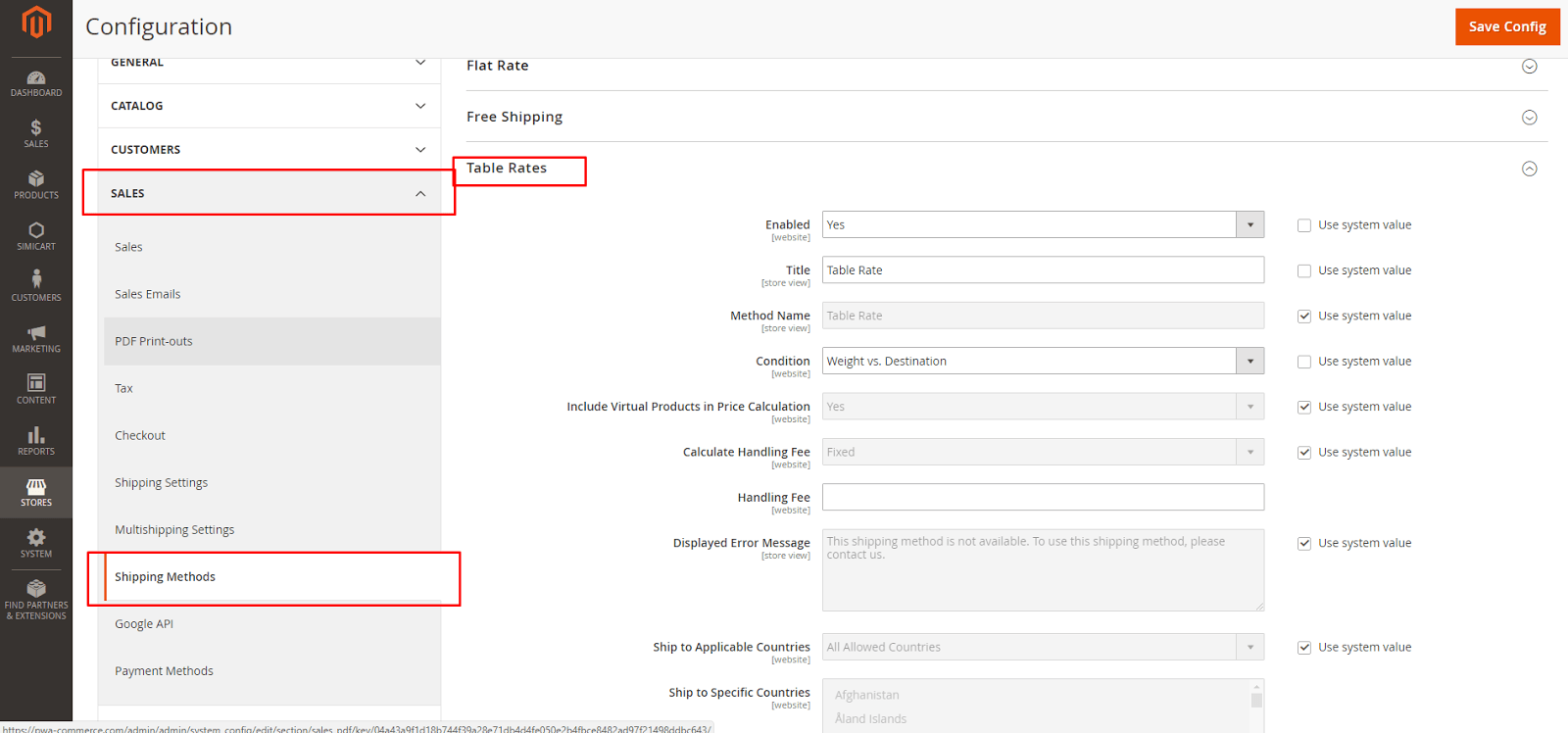Table of contents
Shipping Methods in Magento 2
Along with the growth of e-commerce, Shipping becomes one of the most challenges with every business when customers demand more and more ways for them to be able to receive the items that they purchase online. In this section, we will show you how to config all of your shipping methods with powerful tools provided by Magento 2.

I. Shipping Policy
A shipping policy should explain your company’s business rules and guidelines for shipments. For example, if you have price rules that trigger free shipping, you can explain the terms in your shipping policy.
To display your shipping policy during checkout, complete the Shipping Policy Parameters in the configuration. The text appears when customers click the “See our shipping policy” link during checkout.
To configure your shipping policy
- In the panel on the left, under Sales, choose Shipping Settings
- Expand the Shipping Policy Parameters section

- Apply Custom Shipping Policy: set to Yes
- Shipping Policy: Edit your Shipping Policy here
- Save Config when finish editing
II. Multiple Addresses
The Multi-address Shipping options enable customers to ship an order to multiple addresses during checkout, and determine the maximum number of addresses to which an order can be shipped.
To configure multiple address shipping:
- In the panel on the left, under Sales, choose Multishipping Settings
- Expand the Options section

- Uncheck the box Use System Value to start editing
- Allow Shipping to Multiple Addresses: set to Yes
- Maximum Qty Allowed for Shipping to Multiple Addresses: Enter the suitable value
- Save Config when finish editing
III. Free Shipping
Free shipping is one of the most effective promotions you can offer. It can be based on a minimum purchase, or set up as a cart price rule that is applied when a set of conditions is met. If both apply to the same order, the configuration setting takes precedence over the cart rule.
Step 1: Configure Free Shipping
- In the panel on the left, under Sales, choose Shipping Methods
- Expand the Free Shipping section

- Uncheck the box Use System Value to start editing
- Enabled: set to Yes
- Enter Title and Method Name
- Enter the Minimum Order Amount to qualify for free shipping.
- Displayed Error Message: type the message to appear if free shipping becomes unavailable
- Ship to Applicable Countries: set to All Allowed Countries (Customers from all countries specified in your store configuration can use free shipping) or Specific Countries (After choosing this option, the Ship to Specific Countries list appears. Select each country in the list where free shipping can be used).
- Show Method if Not Applicable: set to Yes (Always shows the Free Shipping method, even when not applicable) or No (Shows the Free Shipping method only when applicable).
- Sort Order: Enter a number to determine the position of free shipping in the list of shipping methods during checkout. (smaller number will be sorted first)
- Save Config when finish editing
Step 2: Enable Free Shipping in the Carrier Configuration
Make sure to complete any configuration that is required for each carrier that you plan to use for free shipping. For example, if your UPS configuration is otherwise complete, make the following settings to enable and configure free shipping.
- Expand the UPS section

- Uncheck the box Use System Value to start editing
- Free Method: set to Ground
- Free Shipping with Minimum Order Amount: set to Enable to require a minimum order for free shipping,
- Minimum Order Amount for Free Shipping: enter the required amount
- Save Config when finish editing
IV. Flat Rate
Flat rate is a fixed, predefined charge that can be applied per item, or per shipment. Flat rate is a simple shipping solution, especially when used with the flat-rate packaging that is available from some carriers.
To set up flat rate shipping
- In the panel on the left, under Sales, choose Shipping Methods
- Expand the Flat Rate section

- Uncheck the box Use System Value to start editing
- Enabled: set to Yes.
- Flat Rate appears as an option in the Estimate Shipping and Tax section of the shopping cart, and also in the Shipping section during checkout.
- Enter Title and Method Name for the Flat Rate method
- Type: describe how flat rate shipping can be used, set to either None (disables the payment type. The Flat Rate option is listed in the cart, but with a rate of zero—which is the same as free shipping), Per Order (charges a single flat rate for the entire order) or Per Item (charges a single flat rate for each item. The rate is multiplied by the number of items in the cart, regardless of whether there are multiple quantities of the same, or of different items).
- Price: charge for flat rate shipping
- Calculate Handling Fee: If charging an additional handling fee, set this field value to either Fixed or Percent. Then, enter the Handling Fee rate according to the method used to calculate the fee. If using a fixed amount calculation, enter the fee as a decimal.
- Displayed Error Message: type the message that appears if Flat Rate Shipping becomes unavailable.
- Ship to Applicable Countries: set to All Allowed Countries or Specific Countries
- Sort Order: Enter a number to determine the position of free shipping in the list of shipping methods during checkout. (smaller number will be sorted first)
- Save Config when finish editing
V. Table Rates
The table rate shipping method references a table of data to calculate shipping rates based on a combination of conditions, including:
- Weight v. Destination
- Price v. Destination
- # of Items v. Destination
The data that is used to calculate tables rates is prepared in a spreadsheet and imported into your store. When the customer requests a quote, the results appear in the shipping estimate section of the shopping cart.
Step 1: Complete the Default Settings
The first step is to complete the default settings for table rates. You can complete this step without changing the scope of the configuration.
- In the panel on the left under Sales, choose Shipping Methods
- Expand the Table Rates section

- Uncheck the box Use System Value to start editing
- Enabled: set to Yes.
- Enter Title and Method Name for the Flat Rate method
- Condition: set to one of the following calculation methods: Weight v. Destination, Price v. Destination or # of Items v. Destination
- Include Virtual Products in Price Calculation: set to Yes if you want to be able to include the virtual product(s) in the calculation for orders that include virtual products.
- Calculate Handling Fee: set to one of the following: Fixed or Percent if charging a handling fee. Then, enter the Handling Fee rate according to the method used to calculate the fee
- Displayed Error Message: type the message that appears if Flat Rate Shipping becomes unavailable.
- Ship to Applicable Countries: set to All Allowed Countries or Specific Countries
- Sort Order: Enter a number to determine the position of free shipping in the list of shipping methods during checkout. (smaller number will be sorted first)
- Save Config when finish editing
Step 2: Prepare the Table Rate Data
- In the upper-left corner, set Store View to Main Website, or to any other website where the configuration applies. When prompted to confirm, tap OK. The Export and Import options now appear in the Table Rates section, with Use Default checkboxes to the right of each option
- To change the Condition, clear the Use Default checkbox. Then, choose another option.
- Tap Export CSV. Then, save the tablerates.csv file to your computer.
- Open the file in a spreadsheet. Then, complete the table with appropriate values for the shipping calculation condition
- Use an asterisk (*) as a wildcard to represent all possible values in any category.
- The Country column must contain a valid three-character code for each row.
- Sort the data by Region/State so the specific locations are at the top of the list, and the wildcard locations at the bottom. This will process the rules with the absolute values first, and the wildcard values later.
- When complete, save the tablerates.csv file
Step 3: Import the Table Rate Data
- Return to the Table Rates section of your store configuration.
- In the upper-left corner, set Store View to the website where this method will be used.
- Next to the Import field, tap Choose File . Select your completed tablerates.csv file, and import the rates.
- When complete, tap Save Config.
Step 4: Verify the Rates
To make sure that the table rate data is correct, go through the payment process with several different addresses to make sure the shipping and handling rates are calculated correctly.



